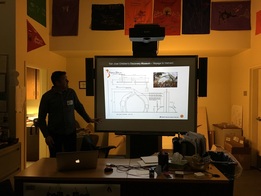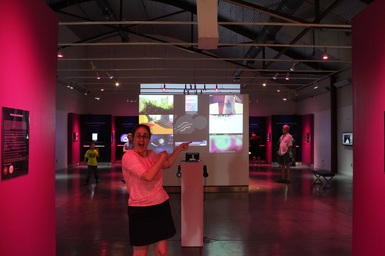|
Every year I head up to an overnight camp in Calistoga called Camp Newman to work with a group of teen campers on a social action issue for a couple of weeks. At the end of their time up there, they will have learned about the issue, spoken with lobbyists and Congressmen in Sacramento, created live happenings, raised money, created social media campaigns, created artwork and poems and songs about the topic. Last year we worked on the topic of Mental Health. The year before that, Food Insecurity. This year we will be tackling the topic of Gun Violence. Every year the kids blow me away with their caring, their leadership and their creativity. This is a timely topic. In preparing to go to camp, I found last year's video and would like to share it here. Camp usually reminds me of what being an educator is all about and inspires me to do better in my classroom next year. I usually walk away with some great new ideas and my cup is just more full for the school year ahead. Can't wait to start this coming week!
0 Comments
Hear from New Tech Network Teachers about what they think of the Innovator's Mindset. Here are two videos about how, you, as a teacher, can get yourself out there, make connections and find professional opportunities. It doesn't have to take up more than 15 minutes at a time, and can open up new doors that you never knew existed. The key is, that blogging and social media go hand in hand and need to be utilized at the same time. Blogging and Social Media TogetherWhy Blog in Education: 3 Case StudiesToday is the day that our final product from Game Design came to fruition. I can't believe that this actually happened. About six months ago, the curator from the Napa Valley Museum, Meagan Doud, called New Tech High, looking for interns to help with a future exhibit about Indie Games. They sent the call to me, thank goodness! At that time, I boldly suggested that instead of recruiting a few interns, why didn't we just have the two Game Design classes I teach take on the exhibit as a school project? I had no idea how awesome it would be! I took the idea to the students and asked permission to let go of the last project of the year, which was to center around coding and drones. Some were reluctant, because, hey, who doesn't love tinkering with drones? But most saw it as an opportunity to do something real and substantial, related to the Game Industry, a field that about half of the 45 students were interested in entering upon graduation from high school, or college. We split the teams up into different sections, some covering music, art, 3D modeling, video, interactivity, early childhood educational components, game mechanics and game careers. Students picked their own areas of interest and away we went. We met with the curator every two weeks, either in person, or via Skype to review questions, status reports and next steps. Two students, one from each class, came to me and asked if they could be the overall project managers. Could they essentially be in charge of the exhibit? Um....yeah! They happened to be two seniors, one who is pursuing Game Design in college next year, and one who wanted to try on the mantle of leadership. Every team also had team project managers (PMs), who were responsible for communicating with the other team PMs, the Lead PMs and with Meagan. There were several PM meetings outside of class to make sure that everyone was on the same page with the project.  Students were asked to consider several target audiences, ranging from families with small children up to attendees from the Veteran's home on the same campus as the museum. Together, we learned about project management skills, from Gantt charts, to Scrum Meetings, to managing resources and deadlines, to using the Design Thinking Method to get clear about prototypes and deliverables. This was a hefty, real world project. It also turns out that we have a New Tech parent who designs exhibits for a living! At the last moment, he jumped in to show off his own work and help the Game Design students really think deeply about how to best engage exhibit visitors. In addition, students learned about 3D modeling, motion graphics, 2D graphics, color theory, writing for signage and exhibits, research, game mechanics and game careers, prototyping, video filming and editing, presenting, and above all, collaboration. I really do hope, that if you are in the area, that you stop by and see the exhibit. It turned out better than I ever could have hoped and I am SO proud of the work that we ALL did together. "Down the Rabbit Hole" runs from July 15, 2016 through January 8, 2017 at the Napa Valley Museum in Yountville, CA, in the Napa Valley and it features 10 Indie Games. There are some great movie nights and Family Fun Days offered, including a Retro Game Marathon, Model Building, Learning about Binary Code and Pixel Art. Look at the very bottom of the blog post for the info. on the show and activities. For me, finding authentic learning projects is a personal passion, and I am convinced that they can not only be done, but done well, can give students real-world experience, and can provide the impetus for some amazing learning. If you have questions for me about authentic learning projects, you can always contact me on twitter @lisagottfried or leave a comment on this post and I'll get back to you. I'm really eager to work on my Master's Program's capstone project. I have chosen to take my schoolwide portfolio project, just rolled out last year, and bring it to the next level. So far, we have taught students how to set-up and create pages in Weebly, as well as created clear guidelines for navigation for the website while allowing for flexibility and expansion of website pages, based on individual need. But, following the TPACK model, that is only addressing the Technology piece of the puzzle and has not yet addressed how this will effect Pedagogy and Content Knowledge. I am excited to now address how students can best use their portfolio to explore three main goals, documenting work, personally reflecting, and providing teaching to others. I will be drilling down on technical skills, exploring how to best communicate to different audiences with different goals, how to use visual design to enhance the message and the learning, and how and why documentation can help students to think through their process, as well as get them connected to the adult world by showcasing their work and their learning processes. I see that there is a HUGE amount of work to do this project, but I feel, that once complete, would be an invaluable resource that could be shared with other teachers throughout the district as well as throughout the New Tech Network. The concept of creating a library of lessons around this subject matter that lives on google drive excites me, as how this information is delivered to the learner can be varied. The whole curriculum could be presented through a website, but it could also be presented as a poster that uses Augmented Reality to share the video content with smart devices that one can point to different icons on the poster. Or perhaps it comes in the form of a booklet with QR codes. Whatever delivery system I choose, the content still needs to live somewhere online and therefore, can be delivered in a multitude of ways, depending upon the needs to the learner. That's pretty cool in my book.
When experiencing or learning a new technology for the classroom, the first questions that come to mind for me include: Why would I use this technology? How does it make my students, better, faster, smarter? Does this make life easier for me or the students or are there more obstacles than value for learning? Would a more low-tech answer still get the same results? Does the new technology engage all of the senses? Is the technology just a "fancy pencil" or does it deepen learning or interaction? If students use this technology, how will it change the interaction with the material? What new paths will open up by using this technology? Will student use of this technology better prepare them for their futures in college or career or is the technology becoming obsolete? Will this new technology last and be adopted by others out in the world or is it a passing phase? Virtual Reality: TPACK Game Changer or Passing Phase?Recently, my high tech-hubby bought an HTC Vive, for business purposes. But, we've been having great fun putting it through it's paces and trying all the games that are currently available for the headset including a 3D painting program, a Myst-like puzzle game, a bow-and-arrow game, some shooter games and a fun game where you shield yourself from spheres of light as you rock out to the music. It's all a LOT of fun.
I have to wonder, though. Is this where education is heading? Are we going to wind up like the characters in Ready, Player, One, where the teachers are virtual, the students go to a virtual school and they take virtual field trips, all through their VR headsets? It's all going to depend on whether or not the audience for VR can grow past the current projected figures of 300,000 - 500,000 for this year. Learning in a VR environment would certainly change every item in the TPACK model, from pedagogy, to content and knowledge to the very context in which learning happens. I see so many possible applications for the VR headsets, but as of now, wearing the devices can only be done for short periods of time, (it gets sweaty) and it's not a social thing yet. You are using the device alone, moving through spaces alone and interacting with computer generated entities alone. But I could see teaching people all about certain body movements through VR. It's the old wax-on, wax-off approach. Want to learn martial arts? Bat away a ton of sparkling balls of light in the right way, and you will soon have the muscle memory for defending yourself with out-blocks and in-blocks. Want to work out your body to increase muscle tone? What if you played a game that took you through an entire work out while you played. In teaching more academic content, want to learn about Mars? Why not go there? Why not orbit for a while before landing on the surface to explore? Learning about history? Go visit the Palace of Versaille or a Medieval Castle, or better yet, live like a serf or a courtier. Fully immersive technology, if it does catch on, will completely change what, where and how we teach. Whether it's Virtual Reality or Augmented Reality, if the technology progresses and is adopted, the future of our classrooms will be totally different than the way they are now. |
AuthorLisa Gottfried is a CTE teacher with 20 years experience as CEO of her own Video and Motion Graphics Production house. She currently teaches Digital Design at New Technology High School and at Touro University in the Masters of Innovative Learning program. She loves her job and her students! Archives
January 2024
Categories
All
|













 RSS Feed
RSS Feed
